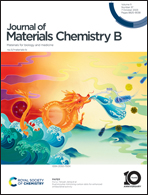Enhanced photothermal therapy performance of D–A conjugated polymers based on [1,2,3]triazolo[4,5-g]quinoxaline by manipulating molecular motion†
Abstract
Donor–acceptor (D–A) conjugated polymers can favor the nonradiative thermal dissipation process, due to the formation of an intramolecular charge transfer (ICT) state resulting from the electron cloud delocalization of the HOMO (highest occupied molecular orbital) and LUMO (lowest unoccupied molecular orbital). Thus, to realize a high extinction coefficient and excellent photothermal conversion ability for a single photothermal agent, donor–acceptor type conjugated polymers PBDT-QTz and PCDT-QTz, comprising a new electron-deficient unit 2-(2-decyltetradecyl)-6,7-dimethyl-2H-[1,2,3]triazolo [4,5-g] quinoxaline (QTz) as the acceptor and 4,8-di(thiophen-2-yl)benzo[1,2-b:4,5-b′]dithiophene (BDT) or 4H-cyclopenta[2,1-b:3,4-b′] dithiophene (CDT) as the donor, are designed and synthesized by manipulating intramolecular motion. The high extinction coefficient of 28.5 L g−1 cm−1 at 850 nm and the optimal photothermal conversion efficiency of 64.3% under an 808 nm laser are achieved based on PBDT-QTz. Consequently, PBDT-QTz nanoparticles can be successfully used for both in vitro and in vivo experiments. After intravenous administration and 808 nm laser irradiation, HeLa tumor-bearing mice achieve complete tumor remission without recurrence. The results provide an efficient photothermal agent by manipulating molecular motion.
![Graphical abstract: Enhanced photothermal therapy performance of D–A conjugated polymers based on [1,2,3]triazolo[4,5-g]quinoxaline by manipulating molecular motion](/en/Image/Get?imageInfo.ImageType=GA&imageInfo.ImageIdentifier.ManuscriptID=D3TB01438J&imageInfo.ImageIdentifier.Year=2023)


 Please wait while we load your content...
Please wait while we load your content...